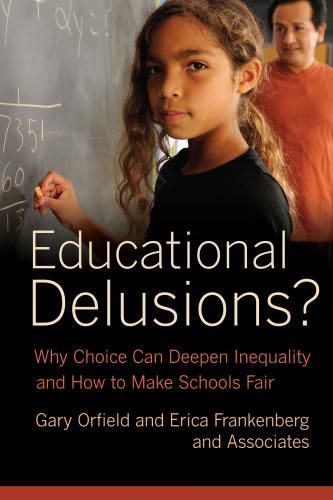NOTES
1. Warner, “Why Are the Rich So Interested in Public-School Reform?”; Riley, “‘We’re in the Venture Philanthrophy Business.’”
2. Kozol, The Shame of the Nation: The Restoration of Apartheid Schooling in America.
3. Peterson, “School Choice: A Report Card.”
4. Welter, Popular Education and Democratic Thought in America.
5. Hochschild and Scovronick, The American Dream and the Public Schools.
6. Weinberg, A Chance to Learn: A History of Race and Education in the United States.
7. Pierce v. Society of Sisters of the Holy Names of Jesus and Mary, at 534–35.
8. Zelman v. Simmons-Harris; Anrig, “An Idea Whose Time Has Gone: Conservatives Abandon Their Support for School Vouchers.”
9. Weiss, ed., American Education and the European Immigrant: 1840–1940; Lieberson, A Piece of the Pie: Blacks and White Immigrants since 1880.
10. Folger and Nam, Education of the American Population, 152–55.
11. Swann v. Charlotte-Mecklenburg.
12. Milliken v. Bradley.
13. Board of Education of Oklahoma City Public Schools v. Dowell.
14. See, for example, Thernstrom and Thernstrom, No Excuses: Closing the Racial Gap in Learning; Carter, No Excuses: Lessons from 21 High-Performing, High-Poverty Schools.
15. Chubb and Moe, Politics, Markets, and America’s Schools.
16. Ibid.
17. Smith, An Inquiry into the Nature and Causes of the Wealth of Nations, 194.
18. He himself was appointed a customs official in Edinburgh at the age of fifty-five. Ibid., vi.
19. Friedman Foundation for Educational Choice, “Milton Friedman on Vouchers.”
20. Ibid.
21. Ibid.
22. Godwin and Kemerer, School Choice Tradeoffs: Liberty, Equity and Diversity, 232–34.
23. Friedman, who lived in one of the most hypersegregated housing markets, Chicago’s South Side, ignored these markets that treated families of different races with the same incomes in extremely unequal ways. Friedman Foundation for Educational Choice, “Milton Friedman on Vouchers.”
24. Critics pointed out, for example, that there were inadequate measures for key variables and that, at best, the public-private difference explained a very small part of the variance in test scores. Fundamental difficulties in the comparisons include a serious problem of selection bias: by their nature, choosing a different school and persisting in transferring a child distinguish parents who do these things from those who do not, whether or not they have the same income and race. There are often unmeasured but important differences in motivation, organization, etc., among parents who make choices in a complex system, and those differences are likely to impact student achievement. Further, schools of choice exercise varying types of control in selecting their students and dropping those who do not conform, something that is far less possible in regular public schools, and they are less likely to have to deal with students and teachers who don’t want to be there. In any case, and even ignoring these unmeasured differences, a raging debate over two decades has produced no compelling evidence of any academic achievement benefits of private schools. Henig, Rethinking School Choice: The Limits of the Market Metaphor; Cookson, School Choice: The Struggle for the Soul of American Education.
25. See, e.g., Bill Gates, remarks at the National Charter Schools Conference; Walton Family Foundation, “Education Reform: Overview.”
26. Ritholtz and Task, Bailout Nation: How Greed and Easy Money Corrupted Wall Street and Shook the World Economy.
27. Madison, Jay, and Hamilton, Federalist Papers nos. 10 and 48.
28. See, for example, Solochek, “Critics Say Florida Lawmakers Are Too Cozy with Charter Schools.”
29. The Center for Responsive Politics reports that a number of charter schools and related organizations are formally registered as federal lobbies. See the search result at www.opensecrets.org/lobby/lookup.php?type=c&q=charter+school (accessed December 21, 2011).
30. Ripley and Franklin, Congress, the Bureaucracy, and Public Policy; ibid., “Interest Groups and the Policy Making Process: Sources of Countervailing Power in America.”
31. See, for example, Kimberley, “Hedge Fund–Funded Charter School Lobby Buys Elections, Destroys Education.”
32. Madison, Jay, and Hamilton, Federalist Paper no. 51.
33. Associated Press, “State Orders Detroit to Close Half Its Schools.”
34. Galatzan, “A Wave of Affiliated Charters: What Does It Mean?”
35. Koretz, Measuring Up: What Educational Testing Really Tells Us.
36. Federal Interagency Forum on Child and Family Statistics, “Language Spoken at Home and Difficulty Speaking English.”
37. Sunderman, Kim, and Orfield, NCLB Meets School Realities: Lessons from the Field, 39–56.
38. Rury and Saatcioglu, “Suburban Advantage: Opportunity Hoarding and Secondary Attainment in the Postwar Metropolitan North.”
39. Ihlanfeldt, “Exclusionary Land-Use Regulations within Suburban Communities: A Review of the Evidence and Policy Prescriptions.”
40. Pfeiffer, The Opportunity Illusion: Subsidized Housing and Failing Schools in California.
41. Wells et al., Both Sides Now: The Story of Desegregation’s Graduates.
42. Clotfelter, After Brown: The Rise and Retreat of School Desegregation.
43. Fuller, Elmore, and Orfield, eds., Who Chooses? Who Loses?: Culture, Institutions, and the Unequal Effects of School Choice; see also chapters 10 and 11.
44. Clotfelter, After Brown; Holme, “Buying Homes, Buying Schools: School Choice and the Social Construction of School Quality”; Charles, “Can We Live Together? Racial Preferences and Neighborhood Outcomes.”
45. Reardon and Yun, “Integrating Neighborhoods, Segregating Schools.”
46. Daniel Kahneman, for example, received the Nobel Prize in Economics in 2002. His work includes studies on the limits of rationality in choice, such as Kahneman and Tversky, eds., Choices, Values and Frames.
47. Schelling, Micromotives and Macrobehavior.
48. Massey and Denton, American Apartheid: Segregation and the Making of the Underclass; Bobo, Schuman, and Steeh, “Changing Racial Attitudes toward Residential Integration.”
49.
